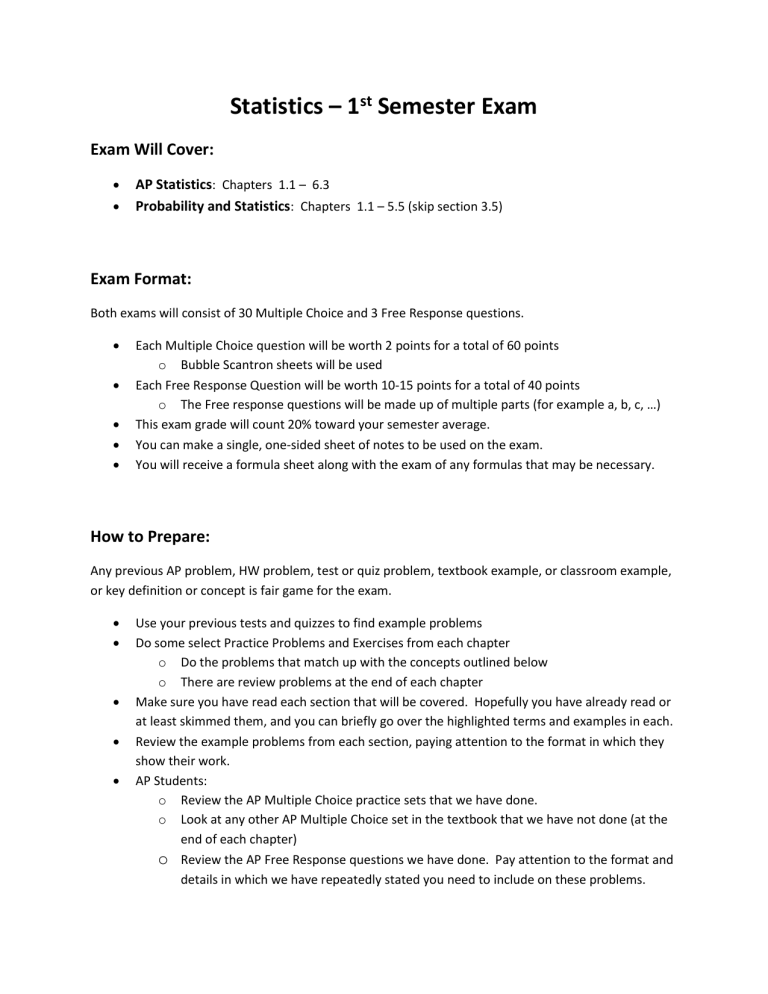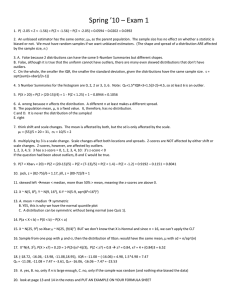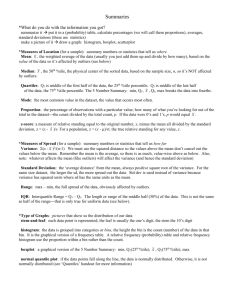Statistics 1st Semester Exam Information

Statistics – 1
st
Semester Exam
Exam Will Cover:
AP Statistics
: Chapters 1.1 – 6.3
Probability and Statistics
: Chapters 1.1 – 5.5 (skip section 3.5)
Exam Format:
Both exams will consist of 30 Multiple Choice and 3 Free Response questions.
Each Multiple Choice question will be worth 2 points for a total of 60 points o Bubble Scantron sheets will be used
Each Free Response Question will be worth 10-15 points for a total of 40 points o The Free response questions will be made up of multiple parts (for example a, b, c, …)
This exam grade will count 20% toward your semester average.
You can make a single, one-sided sheet of notes to be used on the exam.
You will receive a formula sheet along with the exam of any formulas that may be necessary.
How to Prepare:
Any previous AP problem, HW problem, test or quiz problem, textbook example, or classroom example, or key definition or concept is fair game for the exam.
Use your previous tests and quizzes to find example problems
Do some select Practice Problems and Exercises from each chapter o Do the problems that match up with the concepts outlined below o There are review problems at the end of each chapter
Make sure you have read each section that will be covered. Hopefully you have already read or at least skimmed them, and you can briefly go over the highlighted terms and examples in each.
Review the example problems from each section, paying attention to the format in which they show their work.
AP Students: o Review the AP Multiple Choice practice sets that we have done. o Look at any other AP Multiple Choice set in the textbook that we have not done (at the end of each chapter) o
Review the AP Free Response questions we have done. Pay attention to the format and details in which we have repeatedly stated you need to include on these problems.
Main Concepts by Chapter:
Chapter 1: Statistical Reasoning, The Westvaco Case
Section 1.1 Exploring the Data
Dot plots and Distribution
Tables of values and Proportions or Relative Frequencies
Section 1.2 Inference
Using the dot plot to determine if the data values selected likely happened by chance or by discrimination. Use relative frequency, probability, and simple simulations. o A low probability on the simulation indicates that the situation is not likely to have happened by chance.
Correctly writing your inference in context of the problem (think like a lawyer)
Chapter 2: Exploring Distributions
Section 2.1 Visualizing Distributions: Shape, Center and Spread
Know the three key components to describing distribution: Shape, Center, Spread o Uniform, Normal, Symmetric, Skewed, Bi-Modal o Mean, Median and Mode o Range, Standard Deviation, Quartiles
Use the other components if they are present: Outliers, Gaps and Clusters
Section 2.2 Graphical Displays of Distributions
Dot Plot, Histogram, Stemplot (Stem and Leaf), and Bar Chart
Relative Frequency Histogram – know how to convert from histogram
Quantitative versus Categorical Data
Section 2.3 Measures of Center and Spread (more detail than sect. 2.1) **Very Important Section**
Mean (know the basic formula) o Know how to figure out the mean from a frequency table
Median (know how to figure it out for odd and even number data sets)
Mean vs Median placement in a skewed data set (ie: which is shifted further out)
Know what to use for which types of distribution
5-Number Summary for data set (min, Q1, median, Q2, max): know how to find by hand and with calculator
IQR
Determining Outliers: 1.5 times IQR more than the nearest quartile
Box-Plots
Standard Deviation Formula (don’t need to memorize, but do need to understand meaning) o What is the SD basically telling you o Why do we square the deviations from zero (x-xbar) o Know how to figure out the SD from a frequency table using your calculator
Using 1-Var Stats: know what info is on this screen
Section 2.4 Working with Summary Statistics
Mean, Median, SD, IQR, 5-Number Summary
Know when to use which measures for certain types of distributions
Influence of Outliers on the Summary Stats
Recentering a data set
Rescaling a data set
Percentiles (know the definition)
Cumulative Frequency Plots o Be able to convert Frequency, Relative Frequency and Cumulative Frequency Plots
Section 2.5 Normal Distribution **Very Important Section**
Know the basic shape and characteristics of a normal distribution
Know what a “standard normal distribution” is o Mean of 0, SD of 1 o Z-Scores are the # of SDs from the mean
Finding z-scores given mean, SD and a data value
Using z-scores to find percentages within the normal curve o Using z-table and using normalcdf
Using a given percentage to find z-scores o Using z-table and invNorm
Given a z-score find the actual raw data value
Know the central interval percentages vs SDs for a Normal Curve
Chapter 3: Relationships Between Two Quantitative Variables
Section 3.1 Scatterplots
Understanding the relation a scatterplot shows (Independent variable on the x-axis and
Dependent on y-axis)
Describing the pattern: o Identify variables and cases o Describe the shape: linear or curved, clusters and outliers o Describe the trend: positive or negative o Describe the strength of the relationship: Strong, Medium or Weak; or Varies
Understand the idea of generalizing a pattern to other cases
Explanations for the relation
Lurking Variables that could cause the relation
Section 3.2 Creating a Line to Fit the Pattern
Know specifically what slope of the line means in context of the problem. o “the change in the response for every additional unit in explanatory variable
Know what the y-intercept means in context of the problem o The value of the response when the explanatory is zero
Using the line of best fit, regression line, least squares line (all synonyms) as a predictor
Know the details of Residuals
Sum of Squared Errors: just know in general what it tells you
Knowing how to use linreg(a+bx) on calculator
Properties of least squares regression line p.125
Reading computer printout of linear regression o Variable, coefficient, R Squared,
Section 3.3 Correlation: The Strength of a Linear Trend
Correlation = r o r is equal to or between -1 and 1 o The closer to -1 or 1, the closer the points are to the least squares line and the stronger the correlation o Negative r relates to a negative slope, positive r relates to a positive slope
Know how to use the formula for calculating r based on z-scores for x and y values. o Know how the characteristics of the Zs affect r
Comparing r with the shape of the data and analyzing appropriateness of the fit of the line. o Strong r doesn’t necessarily mean a good fit (it could be curved)
Know how to use formula for slope of the line along with r and the SDs for x and y values p.146
Correlation does not imply Causation (possible lurking variables)
Coefficient of Determination, r 2 : know its meaning specifically o The proportion of the variation in the response that is due to the linear relation with the explanatory variable.
Section 3.4 Diagnostics: Looking for Features That the Summaries Miss
Potentially Influential Points: do they change the slope or y-intercept o Points further out in the x direction tend to have more influence on slope o Points way above the line, but directly above the x mean don’t have much effect on the slope
Residual Plots: Know how to create and read them o The more scattered without a pattern indicates a decent fit by the line. o The more a pattern shows up, the more it indicates there is a curve to the data.
Section 3.5 Shape Changing Transformations **Regular Probability and Statistics can skip this section**
Exponential Growth or Decay can be linearized by doing a log (of y) transformation
Power functions can be linearized by doing a log-log (of both y and x) transformation
Simply be able to understand transformations that have been done and answer questions based on what has been done for you. o For example: Is the new data linear or still curved? Which transformation is a better fit? Find the value of y when x is __ with the transformed equation.
Chapter 4: Sample Surveys and Experiments
Section 4.1 Why take Samples and How Not To
Census vs a Sample
Advantages of a Sample
What is the Population and what is a Unit
What is a Parameter
Bias of a Sampling Method: Know the types of sampling bias o Voluntary response, size, convenience, nonresponse, questionnaire, incorrect response
Section 4.2 Methods of Random Sampling
Simple Random Sample (SRS) o Know methods of selecting a truly random sample o Numbering a list and using random table of generator to select
Stratified Random Sample o Know that stratifying can improve accuracy of sample
Cluster Sample
Two-Stage Cluster Sample
Systematic Sample
Section 4.3 Experiments and Inference About Cause
Be careful about making statements of Cause and Effect - because of lurking variables
Two influences on an outcome are confounded if they are mixed in a way that their effects cannot be separated.
Know what a treatment is
Know how an observational study differs from an experiment
Importance of Randomizing
Using a control or comparison group is critical
Placebos
Blind and Double Blind
Experimental Units and Replication
Characteristics of a Well-Designed Experiment o Compare two or more groups o Randomize o Replicate
4.4 Designing Experiments to Reduce Variability
Understand: Differences between Treatment Groups and Variability within Treatments
Why do you want to control variability within treatments? o It is easier to see differences between treatments so your experiment can tell you something. o The difference between treatments must be large enough to overshadow the variation within treatment.
Completely Randomized Design (CRD)
Randomized Paired Comparison (Matched Pairs: match up based on similar ability or some other characteristic. Then randomly assign different treatments to each)
Randomized Paired Comparison (Repeated Measures: Use the same unit and apply each treatment to it)
Randomized Block Design o Block for variation you know about (Block similar thing together) o Randomize for variation you don’t know about
Chapter 5: Probability
Section 5.1 Constructing Models of Random Behavior
Definition of Probability
What an Event is
What a Sample Space is
Law of Large Numbers
Fundamental Principle of Counting
Section 5.2 Using Simulation to Estimate Probabilities
Steps in a Simulation o State your assumptions about the proportions in real life o Describe how the numbers of your model and random selection of them simulate real life o Repetition of the simulation a large number of times. o Write the conclusion of the simulation in context of the problem
Know how to use a random number table or generator on calculator to select numbers that represent random selection of something in real life
Section 5.3 Addition Rule (OR Problems)
Know how and when to use addition formula P(A or B) = P(A)+P(B)-P(A and B)
Know what disjoint (mutually exclusive) means and when it applies or does not apply
Know how to use or create a two-way table to solve problems
May want to know how to use Venn Diagrams (not necessary, but could be helpful)
Section 5.4 Conditional Probability and the Multiplication Rule (AND Problems)
Conditional Probability from a two-way table
Know how and when to use Multiplication formula o P(A and B)=P(A)*P(B|A) or P(A and B)=P(B)*P(A|B) o They are equivalent
Know how to apply the Conditional Probability Formula p.330
Section 5.5 Independent Events
Definition of Independent Events: P(A) and P(B) > 0, Then A and B are independent if and only if
P(A|B) = P(A), or equivalently P(B|A) = P(B).
Then P(A and B) = P(A)* P(B)
Know how to use the above to show events are independent or calculate the probability of combined independent events.
Know “Total Probability” which uses “OR” & “AND” along with conditional probability on a 2way table to figure out the total probability of a given situation.
Section 6.1 Probability Distributions
Know how to create a distribution for a situation (especially when probability is not 50%)
Expected value is the mean of the distribution 1 VAR STAT L1,L2 (weighted average like semester grade)
Can find the standard deviation from 1 VAR STAT L1,L2 also
Recentering, Rescaling of distribution rules
Combining 2 or more distribution rules.
Section 6.2 Binomial Distributions
Know the characteristics of a Binomial Distribution o Looking for a certain number of successes out of a total o There are only two possibilities for each trial (success or failure) o A fixed total number of trials o Each trial independent o Probability of success stays the same
Expected value = np
Standard deviation = sqroot of (np(1-p))
Section 6.3 Geometric Distributions







